| Pages:
1
..
49
50
51
52
53
..
68 |
greenlight
National Hazard
   
Posts: 763
Registered: 3-11-2014
Member Is Offline
Mood: Energetic
|
|
A conical shaped charge and a EFP (hemispherical SC) are totally different from each other.
A conical shaped charge liner turns into a plastic-like jet of high speed copper which makes a small diameter but very deep hole in the target.
A hemispherical liner doesnt get formed into a jet but forms backwards upon itself into a slug of more solid copper that acts more like a bullet using
kinetic energy to punch through the target. Nowhere near as fast as a conical liner but makes a bigger diameter but shallower hole.
Conical shaped charges are only really effective at a standoff of 2-6 cone diameters whereas an EFP is effective from many cone diameter away
depending on size of charge/liner.
There is more differences between the two but those are the basics.
Conical shaped charge would be better if you could get close to the target or for rocket warheads and EFP is better for targets a distance away.
Basically you sacrafice the penetration for a wider hole or vice versa.
[Edited on 26-8-2015 by greenlight]
|
|
|
ecos
Hazard to Others
  
Posts: 464
Registered: 6-3-2014
Member Is Offline
Mood: Learning !
|
|
I think you are right about the trade-off between penetration and the wide of the whole.
I don't know why you think that hemispheres are for EFP , I can find patents talking about hemisphere shaped charge and concentrating the power in
axial point : US5522319 and US342423
quote from wiki :
| Quote: |
By 1886, Gustav Bloem of Düsseldorf, Germany had obtained U.S. Patent 342,423 for hemispherical cavity metal detonators to concentrate the effect of
the explosion in an axial direction.[7]
|
[Edited on 26-8-2015 by ecos]
|
|
|
greenlight
National Hazard
   
Posts: 763
Registered: 3-11-2014
Member Is Offline
Mood: Energetic
|
|
Ah I misread and thought you mean the differences between EFP and conical shaped charges.
The shaped charge in the document you linked is still using the Munroe effect when it detonates to form a jet. That patent design is different from
EFP because the depth of curve in the liner is much deeper and also the liner is thinner towards the edges which will help it form a jet shape more
effectively as the outside of the liner will move the slowest forming the "carrot".
I would think that it would perform very similar to a conical shaped charge but the conical liner design would be slightly superior in penetration and
jet tip velocity. The hemisphere might make a larger diameter hole than the cone though, although it seems the edges need to be thinner for it to
work effectively.
|
|
|
greenlight
National Hazard
   
Posts: 763
Registered: 3-11-2014
Member Is Offline
Mood: Energetic
|
|
Here you go, this might help answer the question more accurately:
Just took some photo's from the pdf document "Introduction to shaped charges" and found pictures of both types of liners.
The first is microsecond pictures of the hemispherical shaped charge being detonated. Note that it still forms a jet but much thicker and not as
elongated.
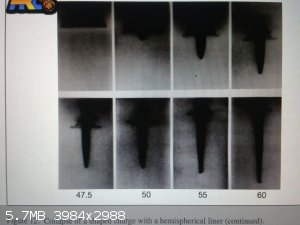
[Edited on 26-8-2015 by greenlight]
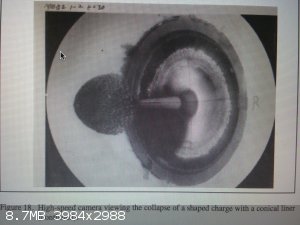 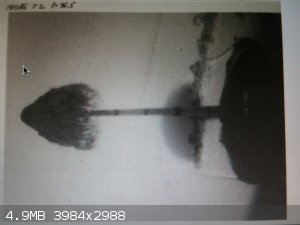
Above is two photo's mid-detonation of a conical shaped charge undergoing detonation. Note how the jet is much smaller in diameter and stretches out
much more.
So, yes, I believe the hemispherical liner would make a larger hole but you would not be getting as high jet tip velocity as a conical shaped charge.
Hope the photos help..
[Edited on 26-8-2015 by greenlight]
|
|
|
ecos
Hazard to Others
  
Posts: 464
Registered: 6-3-2014
Member Is Offline
Mood: Learning !
|
|
Hemisphere shaped charge
Thanks a lot green light.
I also investigated this point. I found this nice article article
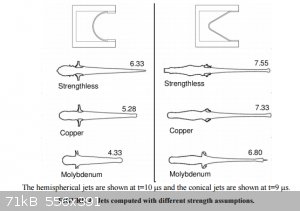
This would make the hemisphere less desired to penetrate targets! I have a real headache for making a symmetric cone ! , it always deform while
working on it! pffff
|
|
|
greenlight
National Hazard
   
Posts: 763
Registered: 3-11-2014
Member Is Offline
Mood: Energetic
|
|
Very interesting article, I am about to read the whole thing but just had a quick look and there is a graph of hemi vs conical liner and it appears
that the conical liner reaches at least 3 -4 Km/s faster jet velocity than the hemispherical liner.
Also this:
"The hemispherical liner collapses into a fairly compact mass that causes a peak stagnation pressure to be reached at about 4.5 µs. The jet tip
reaches a peak velocity shortly after this time, and fastest portion of the jet remains at the front during the entire tip formation. On the other
hand, the jet of the cone forms by the more classical quasi- steady jetting mechanism in which the liner collapses sequentially onto the centerline
from apex to base. The tip forms from the apex region, much earlier time than the hemisphere. Peak stagnation pressure occurs at 3.25 µs for the cone
and peak tip velocity is reached shortly afterwards. Slower tip material formed earlier is pushed away into a cloud of debris by the faster trailing
material."
Yes, unfortunately it does make the hemispherocal liner less desirable penetration-wise.
I have the same problem with forming conical liners as I don't have the equipment needed to form symmetrical copper cones.
I would like to try a method that Neonpulse advised me which involves electroforming the copper liner in a Copper sulphate solution with a former and
using a phone charger as the power source. Seems much easier than other methods.
|
|
|
NeonPulse
Hazard to Others
  
Posts: 417
Registered: 29-6-2013
Location: The other end of the internet.
Member Is Offline
Mood: Isolated from Reality! For Real this time....
|
|
The actual thread is called electroforming copper liners and I think it's in techno chemistry section here. There is a full description there with
PDFs. The possibilities for liners is only limited by the forms you can make.
|
|
|
nitro-genes
International Hazard
    
Posts: 1048
Registered: 5-4-2005
Member Is Offline
|
|
Nice picures greenlight, was the lower one from a tulip shaped liner by chance? The mushroom shape at the tip of the jet is very pronounced with this
type of liner IIRC. The angle for tulip shape would go from relatively wide at the apex, to very steep towards the bottom, creating a jet that may
have an inverse velocity gradient, effectively collapsing on itself, forming IIRC the "crown". This is opposed to trumpet shaped liners.
Any luck yet with capturing the EFP? Maybe this would be a good option? 
--> http://home.boopli.co.uk/product/wilko-pet-bedding-wood-shav...
I would aim for the rabbit 
Hemispherical liners supopsedly can reach similar jet tip velocities as conical liners, when the inhibiting pole region of the liner is not allowed to
collapse. There should be a patent posted somewhere in this thread about this. Hemispherical liners at these charge diamater may also need some extra
subcallibration.
[Edited on 29-8-2015 by nitro-genes]
|
|
|
greenlight
National Hazard
   
Posts: 763
Registered: 3-11-2014
Member Is Offline
Mood: Energetic
|
|
Thanks, nitro-genes, I am unsure because all it says in the description for the pictures is the collapse of a shaped charge with a conical liner.
I tried to catch the EFP again with a line of boxes using wood shavings and dust I collected from a woodwork shop via the vacuum duct dust removal
system that leads it all into a bin outside. It is probably very similar to the stuff in the link that you posted.
I laid about 6 boxes in a line with two styrofoam ones at the front. It managed to escape out the side again though so it was not worth uploading
photos. The projectile seems to tumble and ricochet a lot when it loses some of its velocity which makes it hard to collect. The shot was
dead-centre as well so it isn't the aiming that is the problem.
An interesting observation is that the styrofoam is burnt quite a bit where the projectile passed through leaving a channel 2-3x the size of the
actual slug. It must be pretty hot. I have heard 400-500 degrees C.
I will definitely be trying again as I really want to collect one undamaged.
I will use a triangle shape of boxes starting with one and then two boxes behind it and then three behind that all filled with wood shavings so if it
deviates from its intended path I should still be able to retrieve it.
Will post results
[Edited on 29-8-2015 by greenlight]
[Edited on 29-8-2015 by greenlight]
|
|
|
NeonPulse
Hazard to Others
  
Posts: 417
Registered: 29-6-2013
Location: The other end of the internet.
Member Is Offline
Mood: Isolated from Reality! For Real this time....
|
|
30mm Conical Shaped Charge
Recently I Tested another one of my electroformed liners with pleasing results. total penetration of 80mm, my best effort yet. the angle of this cone
was around 50 deg and just over 1.2mm thick. set into a steel pipe with a thread and steel cap. Head height was 2 CD and standoff was 1.75CD The
filling was 25g PETN and 16ml NG as a slurry mixture.
For safety reasons the target plates were set in a hole the loaded charge placed and a sheath of 50mmID PVC tubing placed around the charge and this
was surrounded by dirt. a plastic cap placed on the tubing with the firing line through it and the remainder of the hole filled and a mound of dirt on
top. I Am very aware of flying steel hazards so I was also behind a huge tree about 50m away.
The charge fired underground with a dull thud and a shower of dirt leaving a large crater and a cloud of smoke
The Target plates were dug up with anticipation and the results was worth all the effort.
6 and a half of the 12mm structural steel plates i had bolted together were punched clean through. Not bad considering the small amount of compounds
used for the result.
I see of this shot too there is the little false jet near the main entry hole, i spent ages ensuring the lot was dead center but even then it
happened.
the pics are of the buried charge the plates unstacked ant the last plate showing the tip, which is kind of the reason i used a stack instead of a
block- its so much easier to see the jet path
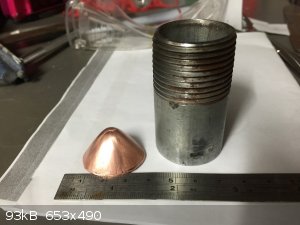 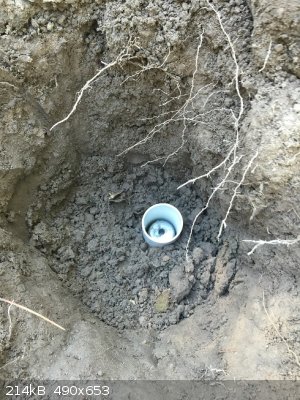 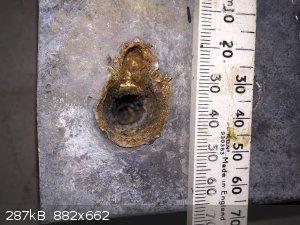 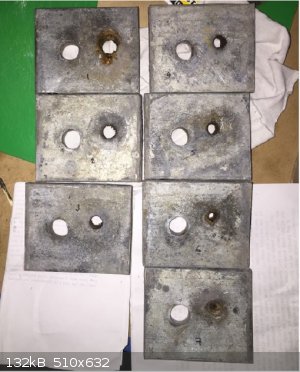 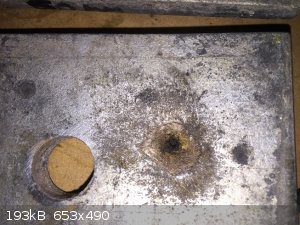
[Edited on 1-9-2015 by NeonPulse]
|
|
|
gnitseretni
Hazard to Others
  
Posts: 283
Registered: 5-1-2007
Location: Colombia
Member Is Offline
Mood: No Mood
|
|
Nicely done!
Angle looks bigger than 50 degrees though. Dunno, maybe the picture makes the angle seem larger?
[Edited on 9-1-2015 by gnitseretni]
|
|
|
greenlight
National Hazard
   
Posts: 763
Registered: 3-11-2014
Member Is Offline
Mood: Energetic
|
|
Well done Neonpulse, I think the 2x explosive height and metal confinement would have enhanced the detonation wave shape and propagation a lot
Nice penetration!
|
|
|
nux vomica
Hazard to Others
  
Posts: 267
Registered: 18-7-2013
Member Is Offline
Mood: No Mood
|
|
Nice neon, not a bad idea burying everything to keep the noise down and absorb any shrapnel from the charge. 
[Edited on 2-9-2015 by nux vomica]
|
|
|
Hennig Brand
International Hazard
    
Posts: 1284
Registered: 7-6-2009
Member Is Offline
Mood: No Mood
|
|
I just took a couple crude measurements from the picture, and using trigonometry (tan function), the apex angle looks to be closer to 65-70 degrees.
Very nicely made liner and very respectable penetration!
"A risk-free world is a very dull world, one from which we are apt to learn little of consequence." -Geerat Vermeij
|
|
|
NeonPulse
Hazard to Others
  
Posts: 417
Registered: 29-6-2013
Location: The other end of the internet.
Member Is Offline
Mood: Isolated from Reality! For Real this time....
|
|
I didn't see that, it was meant to say 60 deg not 50 I have an identical liner and I'll measure the exact angle later.
|
|
|
ecos
Hazard to Others
  
Posts: 464
Registered: 6-3-2014
Member Is Offline
Mood: Learning !
|
|
penetration of 6.5 * 12 mm = 7.8 cm is super amazing with just "25g PETN and 16ml NG as a slurry mixture"
Well done !
|
|
|
NeonPulse
Hazard to Others
  
Posts: 417
Registered: 29-6-2013
Location: The other end of the internet.
Member Is Offline
Mood: Isolated from Reality! For Real this time....
|
|
Quote: Originally posted by NeonPulse  | | I didn't see that, it was meant to say 60 deg not 50 I have an identical liner and I'll measure the exact angle later. |
So it's just less than 60 degrees more like 55.
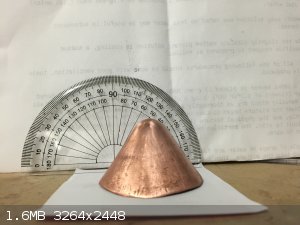
|
|
|
Hennig Brand
International Hazard
    
Posts: 1284
Registered: 7-6-2009
Member Is Offline
Mood: No Mood
|
|
Three corners of a triangle must add up to 180 degrees. The angle you are measuring is the bottom corner angle, which should be about the same on both
sides. So, if it is close to 55 degrees then 180 - (55 * 2) = 70 degrees for the apex angle.
"A risk-free world is a very dull world, one from which we are apt to learn little of consequence." -Geerat Vermeij
|
|
|
nux vomica
Hazard to Others
  
Posts: 267
Registered: 18-7-2013
Member Is Offline
Mood: No Mood
|
|
10 grms through 72 mm steel
I have finally beaten the 32 mm steel plate and then some , I was going for the four 10mm plates tacked together on top of the 32 mm plate but
instead of the 32 mm plate being part penetrated it went straight through it 
the copper cone was 20mm in diameter and 15 mm high and 0.6 thick I used 10 grams of plastic etn ( 1.6 head height) and 50 mm standoff (2.5 x dia )
fired by my ebw fire set through 7 meters rg6 coax.
The jet had narrowed to 2mm by the time it had penetrated 20mm and it basically stayed that dia through the plates.
cheers nux
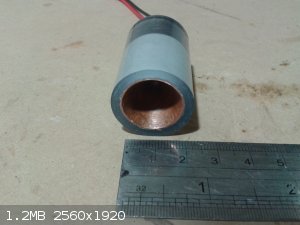 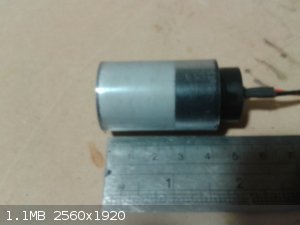 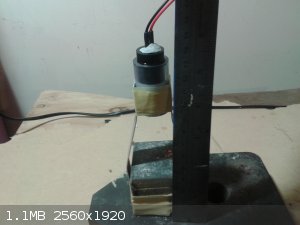 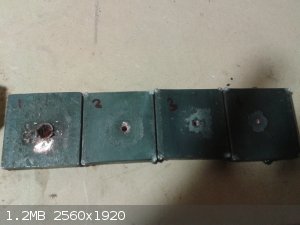 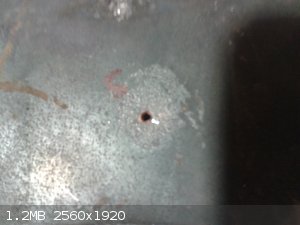 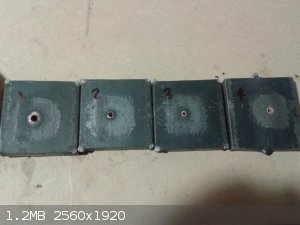 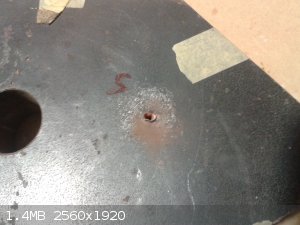
[Edited on 11-9-2015 by nux vomica]
|
|
|
greenlight
National Hazard
   
Posts: 763
Registered: 3-11-2014
Member Is Offline
Mood: Energetic
|
|
Nicely done Nux, seems like that extra 10 grams plastic (you used 5 grams last time if I am correct) and resulting extra head height did wonders for
the jet formation and velocity
|
|
|
nux vomica
Hazard to Others
  
Posts: 267
Registered: 18-7-2013
Member Is Offline
Mood: No Mood
|
|
Thanks greenlight, yeah the extra five grams seem to make a lot of difference to the result I suppose bigger is better. 
|
|
|
aga
Forum Drunkard
    
Posts: 7030
Registered: 25-3-2014
Member Is Offline
|
|
Apppologies for not reading the whole 51 pages of this thead,
It just occurred to me that 'shaping' charges might be a Dynamic thing.
Has anyone tried an arrangement where there are Three parallel lines of charge material.
All detonated at the same time, but the outer charges kind of 'beam-form' the blast from the main explosive.
TDX if anyone ever read 'Cities in Flight'.
[Edited on 11-9-2015 by aga]
|
|
|
NeonPulse
Hazard to Others
  
Posts: 417
Registered: 29-6-2013
Location: The other end of the internet.
Member Is Offline
Mood: Isolated from Reality! For Real this time....
|
|
Nice one nux! I'll bet you could do better still with a PETN or RDX as your main charge. Or perhaps even a mixture of liquid and solid explosives. But
the 72 mm from this amount of explosive= awesome! 
|
|
|
nux vomica
Hazard to Others
  
Posts: 267
Registered: 18-7-2013
Member Is Offline
Mood: No Mood
|
|
Thanks neon, the penertration was better than I expected i thought it might go halfway into the 32 mm steel not through it. 
[Edited on 12-9-2015 by nux vomica]
|
|
|
dangerous amateur
Hazard to Others
  
Posts: 148
Registered: 8-7-2011
Member Is Offline
Mood: No Mood
|
|
| Quote: |
through 7 meters rg6 coax. |
How do you do these tests, did you bury the setup?
7m is extremely short, must be pretty load. How about shrapnel protection?
|
|
|
| Pages:
1
..
49
50
51
52
53
..
68 |